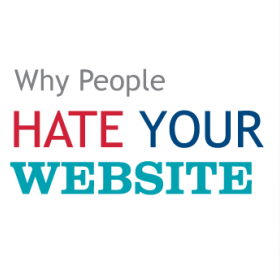Every day, legitimate businesses launch websites that look exactly like the sites your mom always told you never to visit. It’s incredible. Whether it’s flashing icons, pushy sales pitches or broken links, thousands of small business websites appear to be spam straight from the ’90s.
Imagine an alternate reality where history stopped happening after 1998. We’d still have website visitor counters, Clinton would be in his 20th year as president and Star Wars Episode I would never be in a theater near you. Actually, that reality’s not sounding so bad. Except for the visitor counters. Here’s just a few of the spammy leftovers still covering websites. Things we hope you will avoid in your next web design.
Bringing Ugly Back to the Future
Remember Geocities? Ugh. If you need help recalling the nightmare, turn any website into a monster with the Geocities-izer. Does your site commit any of these Internet sins?
- Flashing Anything: Animation and unexpected movement completely distracts from your message. Even simple slideshows should be used sparingly.
- Disorder, Clutter and Brokenness: Does your site look thrown together? Use whitespace to focus your readers and reduce the number of distracting elements. Any broken images or cluttered webpages? Fix that stuff.
- Narrow and Short Pages: In the ’90s, computer interfaces and websites were designed to fit all of the content on a cramped monitor screen without scrolling. Today’s Internet has plenty of sites that require scrolling and re-size themselves to fit any size screen. All those ’90s designs look old and untrustworthy by contrast.
Look Out for Spammy Selling
In marketing, there’s an approach called hard selling. It’s the overt and forceful communication style abused by used-car salesmen. There’s nothing wrong with making your offer clear and encouraging a swift decision. But you shouldn’t hard sell on your homepage. When it’s done wrong, this tone insists on shouting down any objection and disrespects a customer’s decision making. Spam is characterized by pushy and blaring calls to action that take hard-selling right off the edge.
The flip side of hard selling is soft selling. It’s about putting the customer first, answering questions and beginning a relationship. The tone is overall friendlier and the content helps customers make their own decision. But you can be too friendly. Some websites end up looking foolish with an abundance of quirky, cutesy phrases. Just be friendly, helpful and straightforward.
Badges and Widgets Galore
Ever seen a website that just had too much stuff? Social media sites like Facebook, Pinterest and Houzz have tools to display social media content on your website. And business directories and recommendation services often hand out badge images to let the world know you belong. Be careful as you add these over time. They can exacerbate a clutter problem. Think: do you really need every gold star or certification badge? Probably not.
Don’t Try to Please Everybody
All you need to do to guarantee your website is smeared in spam is make everyone happy.
Each website project has additional stakeholders besides the designer and business owner. But it’s not productive to get all those people in a room and try to do everything they want. Jack’s asking for all the social sharing buttons, Jane needs the YouTube video on everything and the family hamster needs his picture on the “Staff” page because little Suzie said so. Those voices should be heard, especially in a tight-knit business, but they cannot dictate action. All website decisions should be made by one person with a strong strategy, not a committee.
 Hate your website? Do customers hate your website? Maybe it’s time to remove those dancing baby GIFs and de-spam your site.
Hate your website? Do customers hate your website? Maybe it’s time to remove those dancing baby GIFs and de-spam your site.
